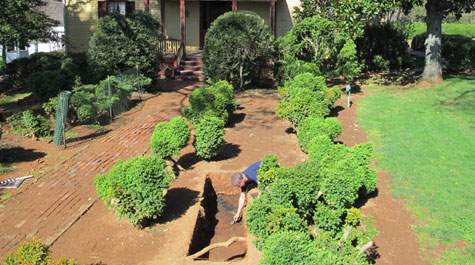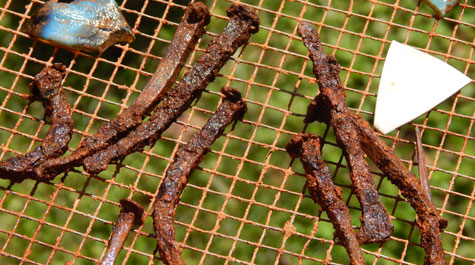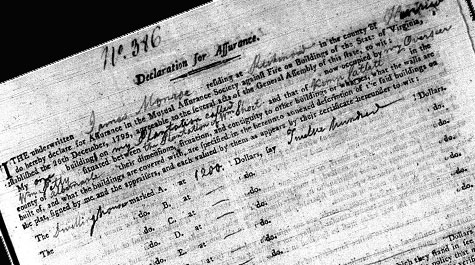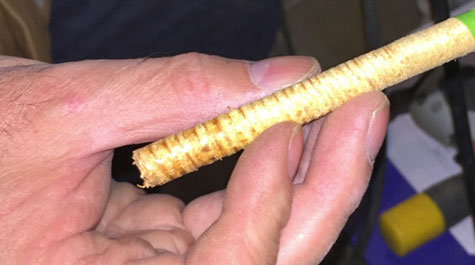Science rewrites history at the home of President James Monroe
Recent excavations at Highland — the historic, Charlottesville home of the nation’s fifth president — are upending history. The archaeology, combined with tree-ring dating, shows that the newly discovered foundation, not the modest home still standing on the property, was the Monroe (1799) house. The property is part of William & Mary and is the only U.S. president’s home currently owned by a university.
“We have made a stunning discovery. These exceptionally well-preserved remains are just beneath the ground surface in the front yard of the 1870s wing attached to the standing Monroe-era house,” said Sara Bon-Harper, executive director of James Monroe’s Highland. “This finding represents a breakthrough in how the nation understands Monroe and how he lived.”
Over his lifetime Monroe, an alumnus of William & Mary, contributed a 50-year career in public service, serving both the Commonwealth of Virginia and the nation in a variety of positions including his two-term presidency from 1817 to 1825.
“People always ask me about the importance of archaeology and how it makes a difference in today’s world,” said Mike Barber, state archaeologist with the Virginia Department of Historic Resources. “Highland provides a prime example of the power of the archaeological record to rewrite history. The evidence is often just below ground and following the best practices of stewardship and archaeology returns the best results, as these findings at Highland prove.”
 The newly discovered foundation shows a free-standing and sizeable house. Bon-Harper said the findings include part of the base of a large chimney preserved below the floor level, several sections of stone wall foundations, segments of thicker walls belonging to a stone cellar now filled with brick rubble, and charred planks, likely pointing to the destruction of the building by fire.
The newly discovered foundation shows a free-standing and sizeable house. Bon-Harper said the findings include part of the base of a large chimney preserved below the floor level, several sections of stone wall foundations, segments of thicker walls belonging to a stone cellar now filled with brick rubble, and charred planks, likely pointing to the destruction of the building by fire.
“Monroe sold the core of his Highland property in early 1826, and it is likely that the house burned sometime in the mid-1800s. We have not yet found contemporary accounts of a fire at Highland, but later newspaper articles refer to the destruction of the former Monroe residence, and the subsequent construction of the new Massey house in its place. The Massey structure was likely completed in the 1870s,” said Benjamin Ford, principal at Rivanna Archaeological Services, LLC, in Charlottesville, the firm conducting research on the newly discovered house.
The discovery of the new foundation is part of larger research efforts on the property, including dendrochronology, the dating of historic wood through tree rings. Dendrochronology was conducted on the modest building that has been long considered James Monroe’s house, providing confirmation that the house now standing on the property dates to 1818, and not 1799 as previously thought.
“Dendrochronology showed the wood in the corner posts of the standing house was cut between the spring of 1815 and the spring of 1818,” said Michael Worthington, proprietor of Oxford Tree-Ring Laboratory in Baltimore.
This later structure is now believed to be a dwelling Monroe mentioned building in a Sept. 6, 1818 letter to his son-in-law. The construction was likely part of a larger renovation and building campaign that Monroe conducted on his Albemarle and Loudon County properties early in his first term as president, Bon-Harper added.
Other artifacts found during the investigations included a significant quantity of bottle glass, ceramics, and fragments of home furnishings.
Bon-Harper said the discovery of the new foundation sets the stage for continued research, noting additional archeology began at the site earlier this month.
“Surprisingly, this home of the last of our founding presidents has so much that remains to be explored archaeologically. The positive identification of the current house as the 1818 building confirms the interpretation of the archaeological remains as the house that Monroe and his family lived in beginning in November 1799,” she said. “Future interpretation on site will incorporate the new revised understanding of the guest house while we continue archaeological research of Monroe’s main house.”
 Beginning this year on James Monroe’s April 28 birthday, tours of the property will reflect the new interpretation of the site. Long-term plans for the property include extensive excavation and eventually virtual reality experiences of the house now being uncovered.
Beginning this year on James Monroe’s April 28 birthday, tours of the property will reflect the new interpretation of the site. Long-term plans for the property include extensive excavation and eventually virtual reality experiences of the house now being uncovered.
Discovery will be the essence of the new visitor experience, Bon-Harper said.
“We believe our research efforts will reveal a greater understanding of the historic resources related to Monroe’s home, and also Monroe’s legacy,” she added. “A long-term research project will be visible to visitors who will witness the unearthing of a new knowledge as part of the historic site visit. “
Highland is located on James Monroe Parkway, Charlottesville, Virginia, adjacent to Monticello and encompasses 535-acres. It was recently re-named with James Monroe’s name for his plantation. It had been previously known as Ash Lawn-Highland, adding the name contributed by a later owner. Highland is open to the public and offers daily tours. The property is also used for community and private events.




















